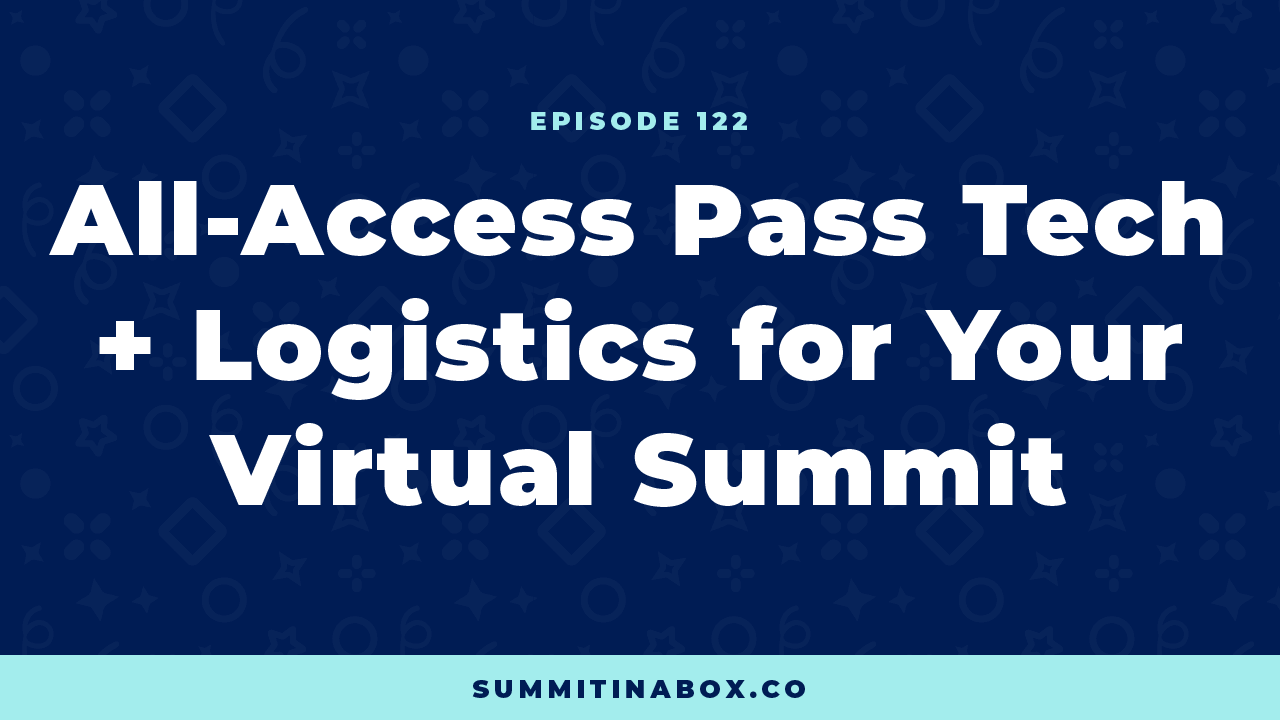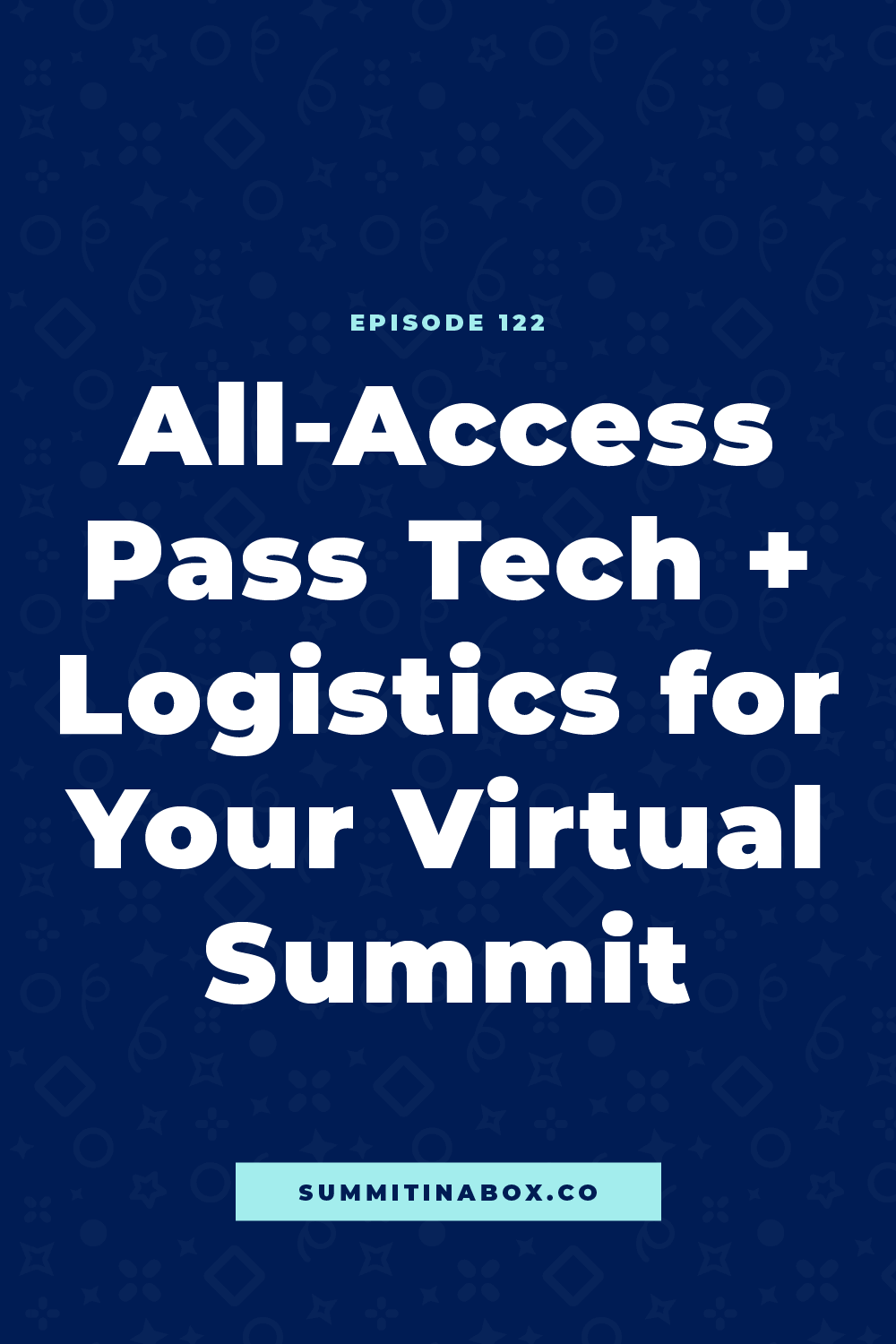All-Access Pass Tech + Logistics for your Virtual Summit


Your all-access pass is an incredibly important part of hosting a profitable virtual summit. It's your first chance to make a solid offer to those who sign up for your event. However, it is a more technical part of the summit-hosting process.
All-access pass tech can feel like a lot but doesn’t have to be scary. As long as you understand the process, you'll have what you need to put the more technical pieces into place.
This includes things like:
- How do the different offers and price points come into play?
- What happens if someone buys the fast-action offer vs if they don't?
- What should happen after someone buys?
- What tech do I need to make it happen?
- a walk-through of what the backend of your all-access pass setup should look like
- what tech goes into that, and
- I’ll share my recommended tech options.
Behind-the-Scenes of All-Access Pass Tech
From Registration to Purchase
Understanding the process attendees will go through from registering for your summit to then buying the all-access pass will give you the knowledge you need to complete the tech setup.
Here's what that process entails:
- Register - First, an attendee registers for free on your summit's registration page.
- Fast-Action Offer - Next, they’re brought to a sales page for your all-access pass fast-action offer (instead of a general Thank You page). At this point, the attendee can choose whether or not to take you up on that offer.
- “Buy Now” - For the sake of sharing these steps, we'll assume they click the “buy now” button, go to your checkout page, and enter their information to buy the all-access pass.
- Email Marketing Tag - Now that they've purchased, they're tagged in your email marketing software as having purchased.
- Buyer’s Email Sequence – They'll also get added to a buyer’s email sequence. This can be as simple as one email that welcomes them, lets them know what to expect, and shares login instructions. (Note: They shouldn’t continue to get emails with the sole purpose of pitching the all-access pass.)
- Member’s Only Area - And finally, they’ll get access to a member’s area that delivers the all-access pass content.
What if someone doesn't take you up on the fast-action offer? After the time limit is up, the fast-action offer isn’t available to those attendees anymore. If they try to go back to that page, they'll be redirected and they can buy at the current “regular” price, where things will pick up again from step 3.
All-Access Pass Tech
Now that you understand how the process works, how in the world do you make it happen? Luckily, there are powerful pieces of software that make the process nice and easy.
To help, I've put together a Virtual Summit Buyer's Guide with all of the resources mentioned here and a whole lot more.
All-Access Pass Sales Page Tech
Your all-access pass sales page should be on whatever platform your registration page is on. This keeps a cohesive design feel and makes the process easy for you.
You’ll have two other types of tech involved on this page:
- Countdown timer - Attendees need to easily see that there's a limited-time offer. One budget-friendly option for WordPress is HurryTimer. Otherwise, my #1 recommendation is Deadline Funnel. The number of additional sales you’ll get because of the countdown timer will pay for itself many times over, so it's an investment worth making.
- Cart software (aka a way for attendees to purchase) - If you already use a cart or checkout platform for your business, use it here. There's no need to reinvent the wheel! For WordPress, I've used WooCommerce and ThriveCart (my #1 recommendation), but I’ve seen others use Podia, Teachable, ClickFunnels, Kajabi, you name it! Use what you're already familiar with.
To integrate your sales page with whatever cart platform you use, set up your checkout page, get a link to it, and set that as the link for your buy buttons on the sales page.
Purchase Thank You Page
Any cart system will give you the ability to either send buyers to a custom Thank You page or take them directly to the member's-only area.
I prefer the custom Thank You page route for a couple of reasons:
- You can add a Facebook pixel, based on whatever pricing option they choose, allowing Facebook to accurately track your return on ad spend.
- The custom page is an extra opportunity to tell customers "thank you" and give specific login instructions.
Build your Thank You page on whatever platform you used for your registration and sales pages.
Email Marketing System
The next piece of this is your email marketing system. This means that whatever tech you use to send emails needs to integrate with your cart software.
Luckily, Zapier makes it easy to integrate just about anything if there isn't a built-in integration, but a quick Google search for “integrate [cart software] with [email marketing platform]” will likely turn up the instructions you need.
Members-Only Area
After someone buys, they'll have access to the members-only area.
The way it works from there is up to you. For example, you can give buyers access to:
- A course platform where content is hosted.
- A zip file of all presentations to download.
- Access to a Google Drive folder container the resources.
To give the most professional experience, I recommend a members-only course platform. I personally use LearnDash on WordPress, but other good options are on Kajabi, Teachable, or Podia. If you already have courses or content hosted somewhere, use that.
Whatever you choose, make sure it can manage access the way you want. For example, if you don’t want buyers to get access to content until the 1st day of the summit or for only 30 days post-summit.
Emails Pitching the All-Access Pass
The last tech aspect to consider is that all-access pass buyers shouldn’t continue to get emails pitching the all-access pass once they've purchased.
In any email marketing system, you should be able to filter who gets emails based on what they're tagged with or what segments they're in.
Some platforms, like ConvertKit, even allow for conditional logic within your emails, which allows you to customize the content within an email.
Now what?
All of this might feel overwhelming, but my advice is to take it one step at a time. Maybe today you figure out your cart platform. Then tomorrow you start to set it up.
Don’t look at it as one big project you have to do right now. Break it down into small, actionable steps you can check off each day.
Resources
- Virtual Summit Buyer's Guide
- Episode 10: Increase All-Access Pass Sales with Limited-Time Offers
- Episode 120: Create an All-Access Pass that Gets Virtual Summit Attendees Hitting 'Buy Now'
- Episode 121: How to Price an All-Access Pass
- LearnDash
- Convert Kit
- WooCommerce
- ThriveCart
- Deadline Funnel
- Summit Host Hangout Facebook group
Pin it for later!



5-Minute Virtual Summit Roadmap
The 5-Minute Summit Roadmap leads you through the 7 essential questions that will guide the rest of your summit planning process and help you finally start making meaningful progress toward a profitable event.

